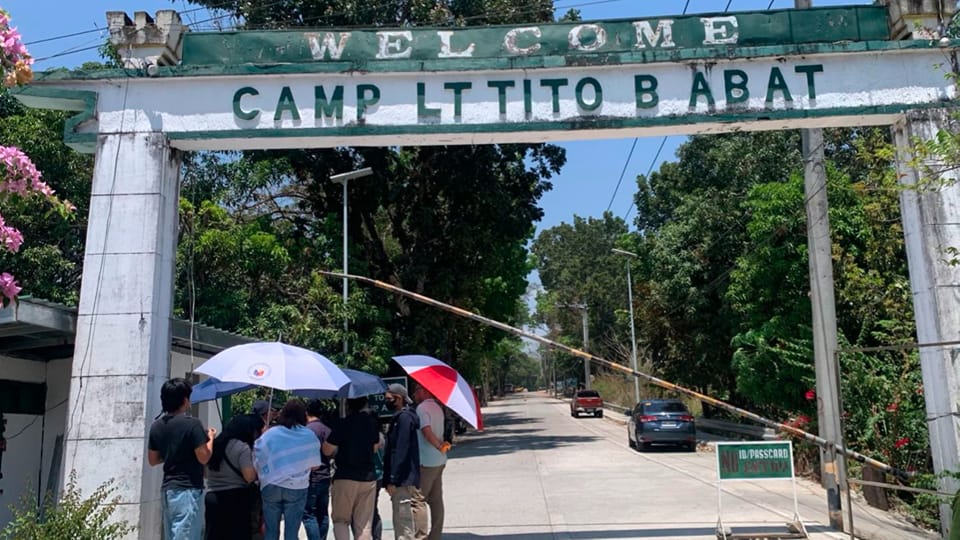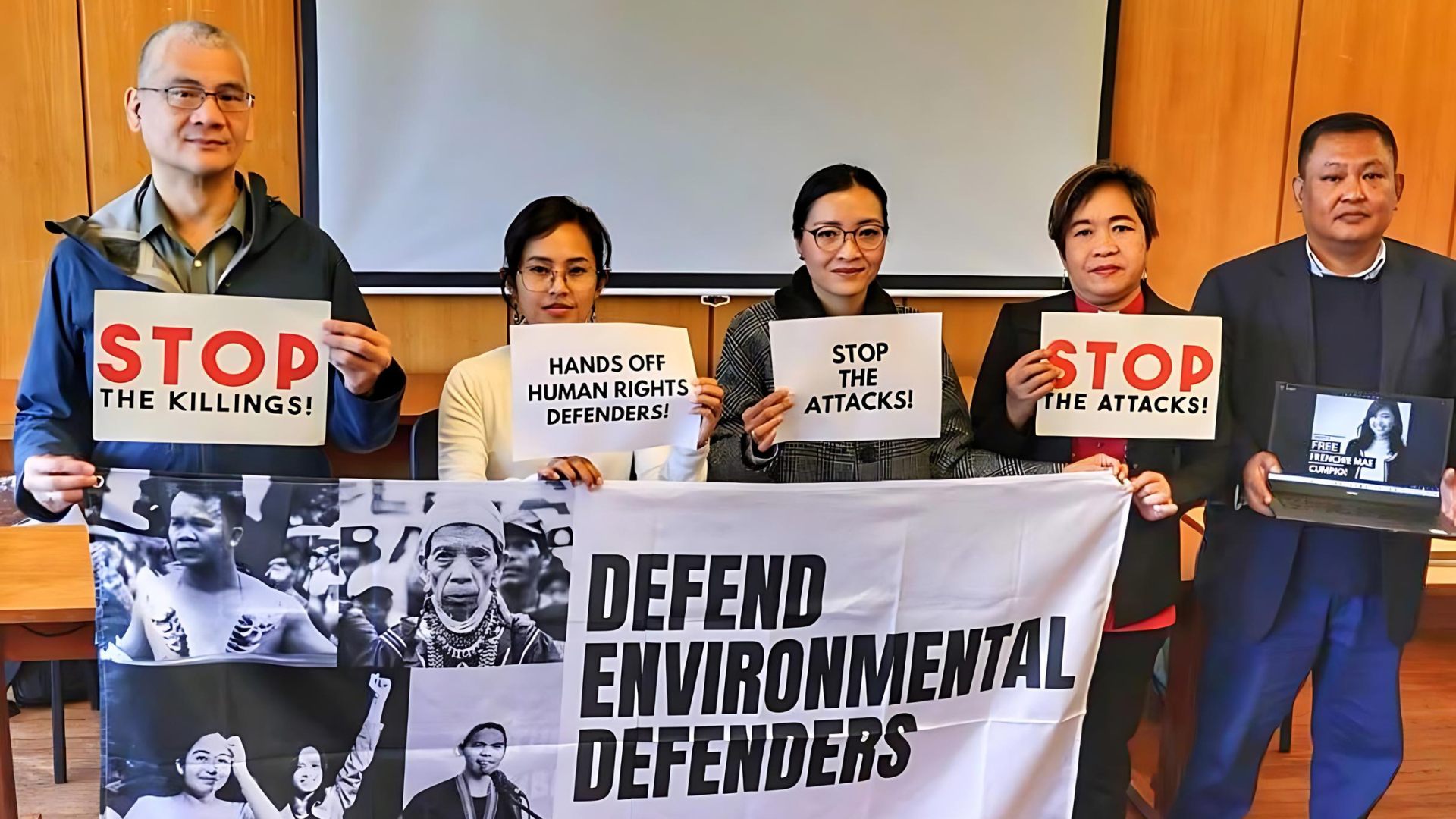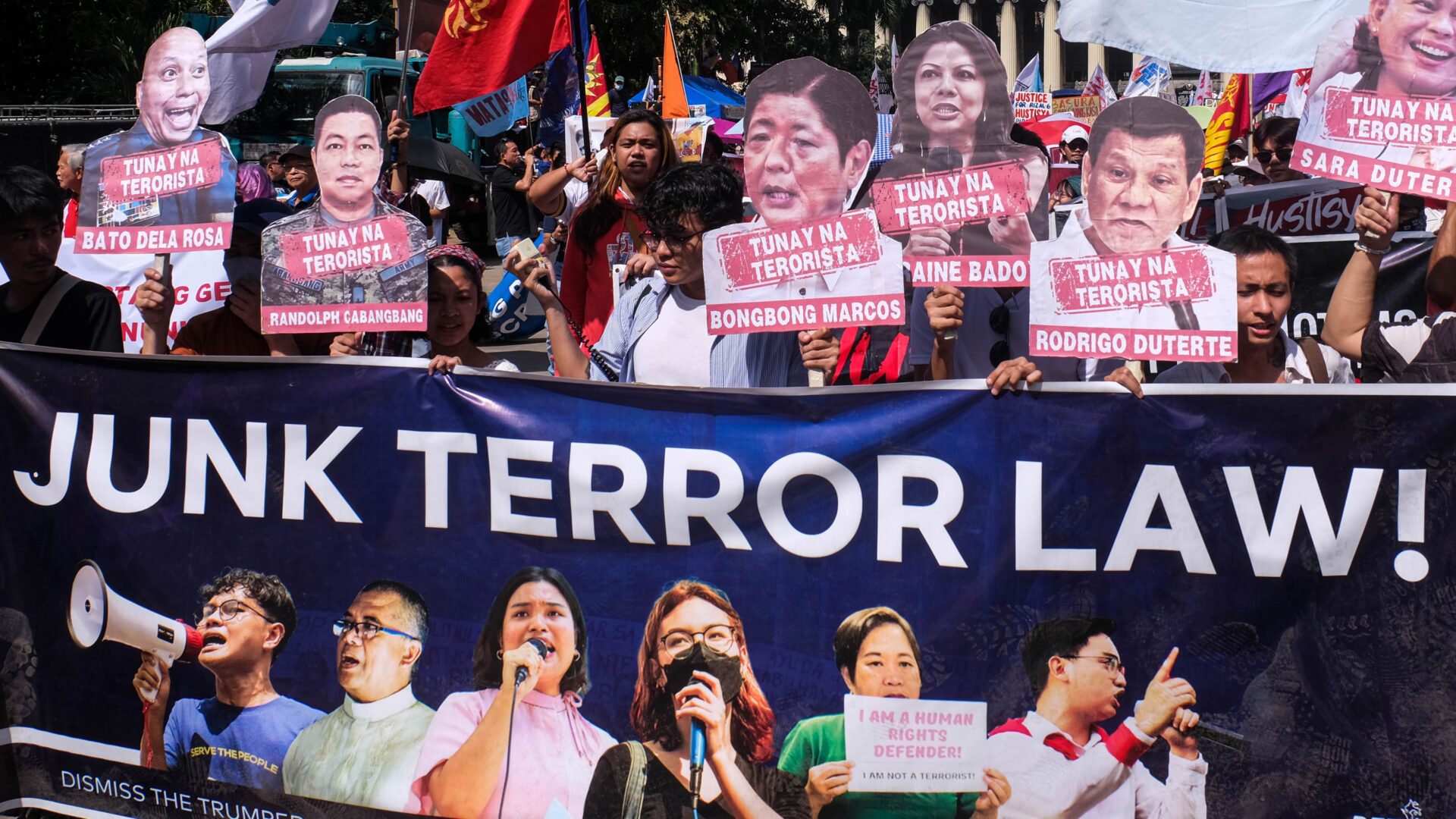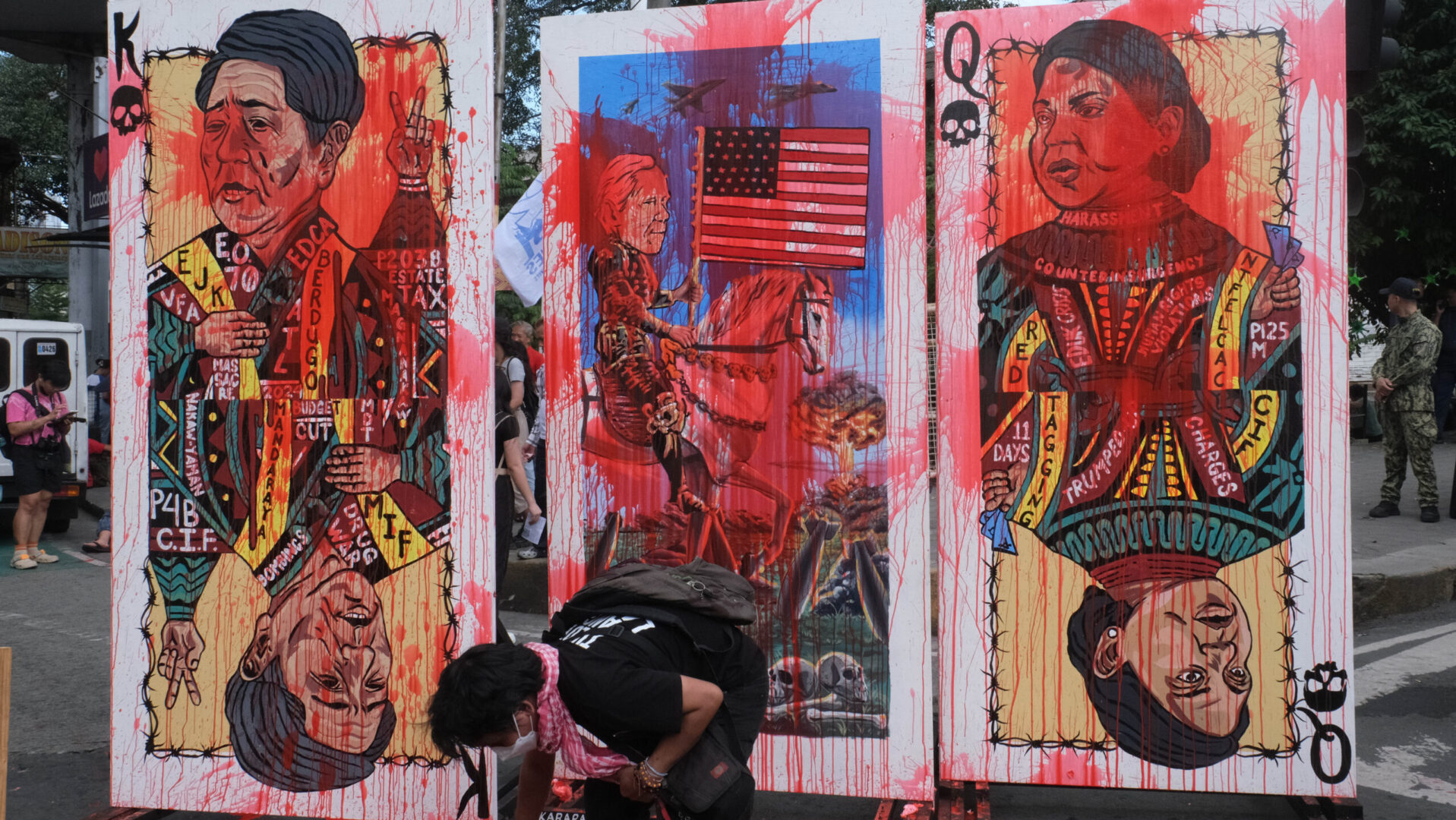THROWBACK | Revolutionaries in enemy hands
What happens after Philippine military and police forces arrest a leader of what it claims to be the biggest security threat to its existence? A “tactical interrogation” ensues, said Voltaire Gazmin, Philippine defense secretary. He said this after Benito Tiamzon, alleged by the military to be the chairman of the Communist Party of the Philippines […]


What happens after Philippine military and police forces arrest a leader of what it claims to be the biggest security threat to its existence?
A “tactical interrogation” ensues, said Voltaire Gazmin, Philippine defense secretary. He said this after Benito Tiamzon, alleged by the military to be the chairman of the Communist Party of the Philippines (CPP), and Wilma Austria, Benito’s wife and alleged CPP secretary-general, were arrested in Carcar City, Cebu, along with five others (plus cats and puppies, their lawyers say) on March 22.
Gazmin’s use of the term “tactical interrogation” is a curious one, as this is a term that often puts fear in the hearts of many an interogatee. Although this is largely denied, the Philippine military takes its cue from the its US counterparts in its use of “harsh interrogation techniques“, from sleep deprivation to outright physical torture, in extracting information from “high-value” detainees. A former political prisoner and the AFP’s “big fish” catch in 2007, Elizabeth Principe, once detailed her own horrific experiences while in the hands of the military. So did many political prisoners, who now languish in jails, charged with trumped-up common crimes.
Way before the US military’s Guantanamo and Abu Ghraib jails gained notoriety for its “harsh interrogation techniques” (sometimes euphemistically called “enhanced interrogation techniques“) on prisoners, the Philippine military, of course, perfected the use of torture during Ferdinand Marcos’ Martial Law from 1972 to 1981. President Aquino, the son of the most prominent anti-Martial Law politician and Marcos’ political rival in Sen. Benigno Aquino Jr., has unfortunately carried on this shameful military practice. This is most evident in the case of the Tiamzons’ arrest, where Gazmin inadvertently admitted that the couple were “interrogated” without the benefit of legal counsel. In the next few days and months, we hope that the arrested couple will be able to recount to the public what sort of “harsh interrogation techniques” the military, under Gazmin’s and Aquino’s watch, employed on them after their arrest.
To have an idea of the torture a “big fish” experiences in the military’s hands, however, we look back at the last time Philippine state security forces boasted of catching a CPP chairman. That was way back in 1977, when Marcos’ military captured and detained Prof. Jose Maria Sison and his wife and comrade, Juliet de Lima.
In 1979, Sison was able to write to the Supreme Court his experiences during the first days of detention. Dated March 13, 1979 (or 35 years ago this month), the letter recounts, in harrowing detail, the torture he endured, as well as the heroic resistance he showed in the face of severe cruelty. Many of the details of Sison’s capture, including the lack of an arrest warrant, are eerily similar to that of the Tiamzons’ capture. Here is that letter, in full:

Most Honorable Court:
I would have liked to speak on a broad range of issues pertaining to the political charges against me. But considering the limited time allotted to me, I shall concentrate on the essential facts of my experience in captivity, as they relate to the violation of certain constitutional rights.
I point out, among others, the unjust redundancy of the charges of subversion and rebellion, with the double jeopardy involved. Most importantly, I deal with the illegitimate foundation of the autocratic government and its military commissions and the falsity of such claims as that a Republic has been saved by a monarchy and a New Society has been built by the preservation and aggravation of the same semicolonial and semifeudal society.
I was arrested together with my wife and three other persons on November 10, 1977, at Barrio Pagdalagan Norte, San Fernando, La Union.
The arresting officers did not carry and did not show any judicial warrant or an executive order specifying the persons and things to be seized, in violation of Section 3 of the Bill of Rights of the 1973 Constitution.
I take lightly the intimidatory acts and words of those who arrested me. I was pushed so hard into a vehicle that my eyeglasses were broken and destroyed at the risk of damage to my eyes. My shins were gashed and bruised.
Soon after I was brought to the C-2 office at Camp Crame, then Captain Virgilio Saldajeno, who said he was a PC legal officer, asked me to make a written statement. I said I could not make a statement until I had a lawyer of my choice. My companions and I jointly and separately asked for access to legal counsel and relatives.

I had a chance to meet and talk with a number of generals and Mr. Marcos no less soon after my arrest.
Past 11 PM on November 10, 1977, I was blindfolded and brought to what I later found out after several months to be the Military Security Unit of the Philippine Army at Fort Bonifacio. I was pushed into a small, suffocating room with a boarded-up window.
For two days, I was subjected to relays of interrogators who kept asking me who was supposed to be my successor in the Communist Party. I refused to answer any of the questions and cited my right to legal counsel.
Events took a drastic turn between 8 and 9 PM on November 13, 1977. Alleged that I was trying to escape, I was blindfolded with my own shirt and handcuffed behind my back by Lieutenant Melchor Acosta (I came to know his real name only on June 23, 1978). Another person came in after a while and I was hit with fist blows on the chest and floating ribs.
I was asked who were the AFP officers connected to the CPP, the armed strength and disposition of the NPA, sources of funds, houses and barrios where I would go in case of successful escape and so on. I was given several blows for every question asked. The punching session must have lasted at least an hour.
Later, I was chained to a cot by one hand and one foot, with handcuffs. The room was dark when I removed my blindfold with my free hand. A large flashlight was constantly on and focused on my face. I was kept awake by two young men in their twenties who made death threats and insults while asking me questions that had been asked before. I was repeatedly told I would be killed as if I had been in the act of escaping if I did not cooperate.
A pistol was always pointed at me by one of the two men. He said from time to time that I would be disposed of the following day. He kept kicking the foot of the cot. He would make a motion of wanting to hit me and the other man would pretend to hold him back. They cursed whenever I told them to let me sleep or to learn methods of investigation from Hawaii Five-O.
Throughout the morning, noon and early afternoon of November 14, 1977, two men, apparently MSU staff officers, alternated in interrogating me, keeping me awake and making veiled threats to finish me off. I can identify these two officers again if I see them because I was not blindfolded.
At about 4 PM of November 14, I was blindfolded again as a swarm of men came into the room. I was able to seem some of them, especially the one who looked like a senior officer (he was later identified to me as Colonel Miguel Aure when he came to my room with Captain Saldajeno on July 14, 1978). I can identify at least three more of these men if I see them again.
My free hand and foot were shackled by handcuffs to the cot, completely binding me to the cot. A pail of water was brought in. A face towel was placed across my nose and mouth. I had to be pinned down by the shoulders as I kept on struggling, lifting the upper part of my body, moving my head vigorously and at times succeeding in loosening the blindfold and seeing the faces of my tormentors. Someone sat down on my stomach to hold me down as the water cure was in progress.
Water was poured into my nostrils through the towel and my mouth was held shut for strangulation effect in order to force me to seek relief and answer questions. When I did not answer or said something they didn’t like a gun barrel was poked into my mouth. They threatened to subject me to electric shocks before they killed me.
The water cure took some six hours. I was asked about 85 questions which I was later able to tabulate. These are listed in my June 23, 1978 account.
My answers or lack of answers appeared unsatisfactory to my tormentors. I had to suffer for names and pseudonyms I was completely ignorant of. I also had to suffer for the names of mountains and barrios I was not aware of. Questions were interrupted by death threats and insults.
Near the end of the water cure, when I was about to fall asleep from exhaustion, one of them tried hypnosis but failed. I was without food and sleep for about 26 hours, from the beginning of the punching session to the end of the strangulation session. Even after the water cure, two relays of interrogators still came after my meal so I was not able to rest until midnight.
Up till November 17, 1977, interrogators came into the room every morning, afternoon and evening. The first ones came at 5 or 6 AM and the last at 1 or 2 AM. I had to maintain my wits and integrity even though I was in a daze. I was not allowed to recover completely from the punching and water cure. I suffered chest pains due to the water cure and my hands were numb from the wrist down as a result of the overtightness of the handcuffs during the torture session.
It was two months before I fully recovered from my chest pains and three months before the numbness left my hands.
On the morning of November 17, someone came to offer a deal, a reunion with my wife for one regional secretary of the Communist Party of the Philippines. I merely ground my teeth at him.
Late afternoon that day, Captain Saldajeno came with another officer to make an offer. The torture and interrogation would stop if I made a statement that would incriminate myself and no others. All I was to do was declare that I am Amado Guerrero, Chairman of the Central Committee of the Communist Party of the Philippines.
Although Captain Saldajeno and his companion conducted themselves like gentlemen it was clear that the statement was being extorted from me. In view of what I had already undergone and was still undergoing and also in view of the danger that anything could be done to me and could be claimed of me while I was in solitary confinement, I accepted the offer on the additional condition that the statement would include a part declaring that I would not be making any other statement while I did not yet have a lawyer of my choice, while I was still in the custody of the military and that I would soon be present in court.
I was actually compelled to sign a death warrant. I was not concerned with saving my life because I was aware that the death penalty would be applied under Republic Act 1700 by incriminating myself as the CPP Central Committee Chairman. My uppermost concern was to preclude the possible fabrication of a statement that would incriminate others and make me appear as one shamelessly untrue to the democratic cause.
In gross violation of Section 20 of the Bill of Rights, I was under duress and I was compelled to be witness against myself. Though Captain Saldajeno and Agent Calayag saw it fit to induce me to make such a statement, they did not see it fit to allow me to consult with a lawyer of my choice and did not inform me of my right to remain silent and to have a lawyer.
They took advantage of my forced isolation and the force, violence, threat and intimidation applied on my by offering relief in exchange for the self-incriminatory statement. A person of my educational background and political experience could not have refused to remain silent and to have a lawyer as a matter of right had he been allowed to exercise it.
After the statement on November 18, 1977, I was relieved of the frequent interrogations and I was allowed to recover physically. But I was continually subjected to what turned out to be a worse form of torture. It was mental torture through physical isolation, constantly in chains and other straining conditions. It was clear my tormentors still wanted me to break my nerves or my principles.
I repeatedly asked for access to a lawyer, my wife, others arrested with us and our relatives. My custodians never gave an answer, except some mocking remarks from inspectors who looked through a bay window of my cell door.
The days, weeks and months passed until August 7, 1978, when my mother, father, sister and lawyer were allowed to visit me.
One or two officers would come to my cell once every two weeks from December 1977 to the middle of February 1978. Then they ceased to come to complete my isolation. My guards were prohibited from speaking to me except when they say something in behalf of their superiors.
I was kept in a fully enclosed cell, a small room with a boarded-up window. From 11 AM to 5:30 PM during November to January, it was oppressively hot. In the summer months, it was practically hell during the day and even at night. During the day, a wet cloth dried up in a few hours’ time.
I was shackled to my cot by my right hand and foot from November 13, 1977 to June 23, 1978 for 24 hours a day. I consider that even more savage than the punching and strangulation sessions. I was told by an officer and guards that I had to be chained because I had refused to cooperate or because I would escape or commit suicide.
For four months I was deprived of my eyeglasses despite the unequal visual capacity of my eyes. I had to suffer eyestrain and headaches every day. I was told I did not need eyeglasses because I had nothing to read from the ceiling and walls.
I had nothing to read for four months. I was given something to read for a few days and again I had nothing to read for a longer stretch of time.
Until now, I remained in chains in the same cell. Since June 23, 1978, I have been disconnected from my cot but I am still shackled on both feet by handcuffs during my waking hours, limiting my movements. At night, I am chained to the cot. The inspectors still come often to flash a light on me.
From November 10, 1977 to January 17, 1978, I was not allowed any sunshine. The next 11 months I had just 24 hours total of sunshine. The standard prison rule is one hour daily sunning even for criminals already condemned to death. Only since December 1978 was I allowed to have some sunshine but still only three times a week for an hour each day.
Whenever I am brought out of my room for any reason, I am blindfolded. The blindfolding sometimes becomes painful when I am bumped into things by careless or mischievous escorts. I feel it is designed more to humiliate me than anything else.
I have not been allowed to read even the Marcos-controlled newspapers of Manila. Reading materials from relatives and friends are not allowed to reach me. When Attorney Joker Arroyo gave me a copy of the pamphlet “Legal Rights of Political Detainees” last February 23 during a hearing, it was immediately confiscated as soon as I was out of public view. When Attorney Juan T. David, my lawyer, gave me a copy of his Habeas Corpus petition to the Supreme Court involving my wife and me, it was also taken away as soon as he left the MSU reception room last February 28.

Visitations by lawyers and family allowed to me since August 7, 1978, have been so restricted that in effect there is only one person in my family who can visit me.
My wife and I are detained in the same compound. After more than 15 months since our arrest, we have still not been allowed to meet and talk by ourselves at some reasonable length, despite precedents which allow not only conjugal meetings between co-accused husband and wife but even temporary release on account of children.
My mother and sister wanted my wife and me to be visited by religious people. I have agreed to welcome their visit since August 7, 1978 but my custodians do not allow them. I was told one time that communists do not talk to religious people. Another time, I was told that religious people are in collusion with communists.
My requests for medical and dental treatment from MSU medical personnel have not been attended to for periods as long as five months. Each time that my dental treatment was allowed, the attention was superficial and incomplete. The last time my two lower front teeth were treated for filling, my dentist practically busted these plus one more tooth, dealing permanent damage to them. I am also skeptical of the medical treatment I last received concerning an obstruction in the pupil of my left eye.
In isolation, minor vexations that might be dismissed as trifling can spell misery. Once I was asked to undress completely in my cell to be inspected thoroughly before meeting a visitor. When I was chained to my cot 24 hours a day I was not allowed to clean my cot and get rid of bugs. I was not allowed to have my hair or nails cut for as long as five months. While eating, my guard would tell me to hurry up because he had a loose bowel movement.
My handcuffs were replaced with new ones with sharp edges and tightened at the slightest pressure. When I complained they were replaced by handcuffs with only one chain link (usually they have two or three) to limit my movements more.
As a result of this statement, I am almost certain there will be series of retaliations against me. It has been my experience that whenever I make a request or demand and at the same time invoke a certain right my custodians or higher authorities always seem to take offense and react by not only refusing to accede to the request but also doing something to make my situation worse. It seems that in their view I have lost every right.
Upon the good counsel of my lawyer, I insist upon certain constitutional rights in this statement. In another statement, I make a comprehensive and fundamental criticism and condemnation of the antinational and antidemocratic reign of terror and greed. By actively participating in my legal defense, I try not only to expose, delay or stay the hands of injustice about to smite me but also to continue doing my bit in the defense of the people’s democratic cause.
I am aware that so far my ordeal in the hands of the fascists is slight in comparison to the torture suffered by several of my co-accused. It is also nothing in comparison to the torture and murder of thousands of revolutionary martyrs. I am determined to keep on fighting and I am prepared to undergo further brutality until my tormentors finally decide to kill me.
The broad masses of the people will eventually put the whole lot of their oppressors in their proper places. Right now, the organized democratic revolutionary forces are steadily growing in strength and advancing. U.S. imperialism and the local exploiting classes will utterly regret that the fascist regime has only served to accelerate the rise of the revolutionary forces and the doom of the already outmoded system.








